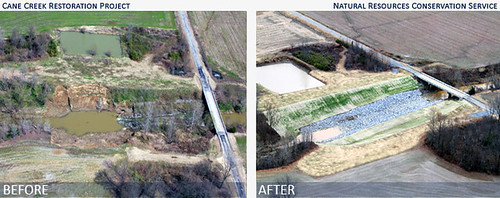
Steve Koonce, a Civil Engineering Technician with USDA’s Natural Resources Conservation Service (NRCS), remembers swimming in Tennessee’s Cane Creek as a youngster, when he and friends would jump from a bridge into the water 15 feet below. But today, because of a catastrophic erosion problem, that activity would be a lot more dangerous.
“Today if you jumped off the same bridge, you would need a parachute,” says the Lauderdale County native.
Erosion along Cane Creek, in the southwestern corner of the state near Memphis, has led to the loss of tons of healthy soil and farmland and the crippling of bridges due to unstable stream banks. But thanks to a $14-million project funded by the American Recovery and Reinvestment Act of 2009 (the Recovery Act), the problem has been addressed, protecting valuable farmland and the residents of Ripley, where rainstorms have caused bridges to fail and significant amounts of soil to wash away.
The funds were used to repair several degraded bridges, address massive erosion and flooding on prime farmland adjacent to the steam, and prevent flooding to nearby homes and businesses. The nearly four-year project was completed in October 2012.

As a result, more than 1,000 acres of prime farmland soils have been protected from erosion. Six public bridges were preserved and a stimulus of $100 million was invested in the local economy. Farmers with property near Cane Creek can now prosper since valuable soil and seeds will no longer be washed away with each rain event.
But this project didn’t just protect the river and those who live along it—it also infused money and jobs into the area.
“Almost every person that worked on the Cane Creek project slept in the local hotel, ate at the local restaurants, washed clothes at the local laundry mat and gassed their truck up at the local gas station,” McDaniel says. “All that really makes a difference in a small town like Ripley, home to 27,101 residents.”
NRCS provided additional technical guidance and financial assistance to help farmers create and implement conservation plans. Conservation practices were implemented throughout the watershed, including 128 erosion control structures such as dams and diversions that control the changes in water elevation.

“Without this help, my crop field would have been washed away,” says farmer and local resident George Meadows.
This project was a result of a partnership between the landowners, local, state and federal agencies, environmental agencies and conservation organizations.
Learn more about NRCS Recovery Act Programs.
Follow NRCS on Twitter.
Check out other conservation stories on the USDA blog.
